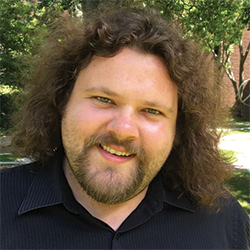Imaging paper earns chemist
a 2018 Tabor award
Most home bakers get a brown shine on their pretzels by dipping the dough into a boiling bath of water and baking soda. But for Richard J. Karpowicz Jr., it’s all about the base.
“I’m a chemist, so I make traditional German lye pretzels with one molar sodium hydroxide,” he said. “I wear gloves, and I kick my girlfriend out of the kitchen.”
 Richard Karpowicz Jr. developed a tag-and-quench fluorescence imaging approach to study Parkinson’s proteins. Courtesy of Richard Karpowicz Jr.
Richard Karpowicz Jr. developed a tag-and-quench fluorescence imaging approach to study Parkinson’s proteins. Courtesy of Richard Karpowicz Jr.
Karpowicz, a postdoctoral researcher at the University of Pennsylvania, received a 2018 Journal of Biological Chemistry/Herbert Tabor Young Investigator Award for other pursuits in chemistry. With his colleagues, Karpowicz developed a new approach to image aggregation and transmission of a protein associated with Parkinson’s disease, work that appeared in JBC last year.
Raised in Lawrenceville, New Jersey, Karpowicz went to the University of Delaware as an undergraduate intending to major in chemical engineering. His father, Richard J. Karpowicz Sr., had earned a Ph.D. in chemistry at the University of Delaware and introduced him to scientific thinking at a young age.
“I grew up doing a lot of fishing with him, and he would explain the tides and sunrise and sunset,” the younger Karpowicz said. “He always took a scientific perspective on explaining the natural world in a way that was accessible to me as a kid.”
In college, Karpowicz fell in love with biochemistry and changed his major. His research into catalyst design with Joseph Fox won him Pfizer and Howard Hughes Medical Institute funding.
Karpowicz’s interests have repeatedly pulled him from pure chemistry toward its interface with biology. In graduate school, he intended to continue with synthetic organic chemistry but heard about Dali Sames at Columbia University who develops fluorescent neurotransmitter analogues to track vesicle release.
“That’s where I got involved in tissue culture, assay development, and biological and biochemical and optics-based methodology,” he said.
After earning his Ph.D., Karpowicz wanted to develop techniques to tackle unsolved problems. He joined the lab of at the Center for Neurodegenerative Disease Research at the University of Pennsylvania.
“When I interviewed here, the most important question was, ‘How can we measure internalization of (alpha-synuclein seeds) or where they go inside the cell? How can we shed some light on what actually happens inside a neuron?’”
He pitched a plan that came to fruition in his JBC paper.
And on his cooking hobby, he reflected, “It’s fascinating what kind of flavors can develop through different cooking techniques. It’s all chemistry, right?”
Watching the spread of neurodegeneration
A number of neurological disorders, including Parkinson’s, Alzheimer’s and Lou Gehrig’s disease (formally known as amyotrophic lateral sclerosis) are caused by aggregation of proteins within neurons. This process can be seeded in cultured neurons by introducing clumps originally formed in a test tube.
Richard Karpowicz Jr. and colleagues developed a new fluorescent approach to track alpha-synuclein clumps only after they are internalized by cells. The researchers tagged the seeds with a fluorescent protein but then quenched all fluorescence outside of the cell. They published the work in June in JBC.
The authors confirmed that added alpha-synuclein, the protein responsible for Parkinson’s disease, is taken up and stored for days within the cell. By adding a second, acid-sensitive fluorescent tag, they showed that protein clumps are kept in the acidic environment of the lysosome and that disrupting lysosomal storage leads to increased seeding of new clumps.
This suggested to the authors that just a few events are enough to seed significant aggregations.
For more on this paper, see the article in the November issue of ASBMB Today, “Tracing the path of Parkinson’s proteins.”
Enjoy reading ASBMB Today?
Become a member to receive the print edition four times a year and the digital edition weekly.
Learn moreGet the latest from ASBMB Today
Enter your email address, and we’ll send you a weekly email with recent articles, interviews and more.
Latest in People
People highlights or most popular articles

Transforming learning through innovation and collaboration
Neena Grover will receive the William C. Rose Award for Exemplary Contributions to Education at the 2025 ASBMB Annual Meeting, April 12–15 in Chicago.

Guiding grocery carts to shape healthy habits
Robert “Nate” Helsley will receive the Walter A. Shaw Young Investigator in Lipid Research Award at the 2025 ASBMB Annual Meeting, April 12–15 in Chicago.

Leading the charge for gender equity
Nicole Woitowich will receive the ASBMB Emerging Leadership Award at the 2025 ASBMB Annual meeting, April 12–15 in Chicago.

Honors for de la Fuente, Mittag and De La Cruz
César de la Fuente receives the American Society of Microbiology’s Award for Early Career Basic Research. Tanja Mittag and Enrique M. De La Cruz are named fellows by the Biophysical Society.

In memoriam: Horst Schulz
He was a professor emeritus at City College of New York and at the CUNY Graduate Center in Manhattan whose work concentrated on increasing our understanding of mitochondrial fatty acid metabolism and an ASBMB member since 1971.

Computational and biophysical approaches to disordered proteins
Rohit Pappu will receive the 2025 DeLano Award for Computational Biosciences at the ASBMB Annual Meeting, April 12-15 in Chicago.

